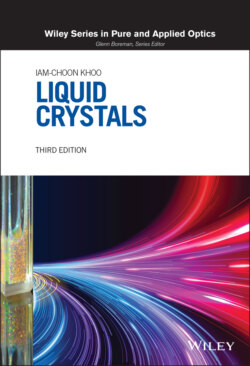Читать книгу Liquid Crystals - Iam-Choon Khoo - Страница 43
3.2. ELASTIC CONTINUUM THEORY 3.2.1. The Vector Field: Director Axis
ОглавлениеIn elastic continuum theory, introduced and refined over the last several decades by several workers [1–3], nematics is basically viewed as crystalline in form. An aligned sample may thus be regarded as a single crystal in which the molecules are, on average, aligned along the direction defined by the director axis .
The crystal is uniaxial and is characterized by a tensorial order parameter:
(3.1)
As a result of externally applied fields, stresses/constraints from the boundary surfaces, the director will also vary spatially. The characteristic length over which significant variation in the order parameter will occur, in most cases, is much larger than the molecular size. Typically, for distortions of the form shown in Figure 3.1a–c, the characteristic length is on the order of 1 μm, whereas the molecular dimension is on the order of at most a few tens of angstroms. Under this circumstance, as in other similar systems or media (e.g. ferromagnets), the continuum theory is valid.
Figure 3.1. (a) Twist deformation in a nematic liquid crystal; (b) splay deformation; (c) bend deformation.
The first principle of continuum theory, therefore, neglects the details of the molecular structures. Liquid crystal molecules are viewed as rigid rods; their entire collective behavior may be described in terms of the director axis , a vector field. In this picture, the spatial variation of the order parameter is described by
(3.2)
In other words, in a spatially “distorted” nematic crystal, the local optical properties are still those pertaining to a uniaxial crystal and remain unchanged; it is only the orientation (direction) of that varies spatially.
For nematics, the states corresponding to and – are indistinguishable. In other words, even if the individual molecules possess permanent dipoles (actually, most liquid crystal molecules do), the molecules are collectively arranged in such a way that the net dipole moment is vanishingly small; that is, there are just as many dipoles up as there are dipoles down in the collection of molecules represented by .
